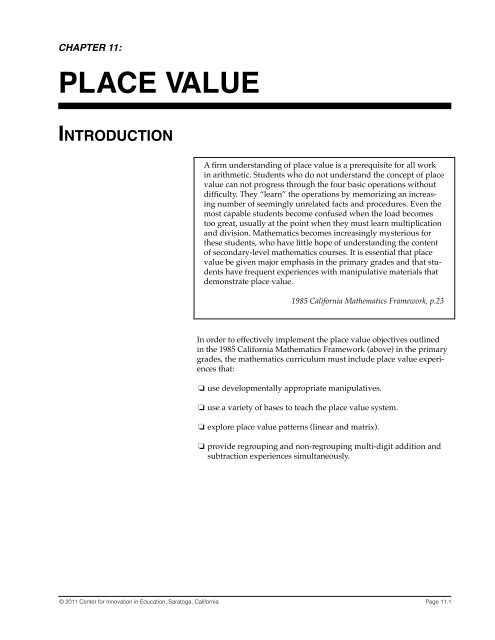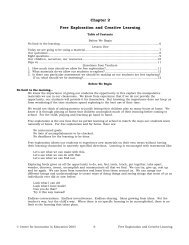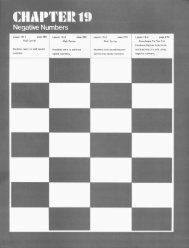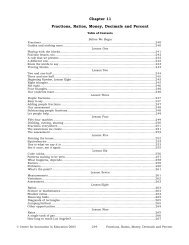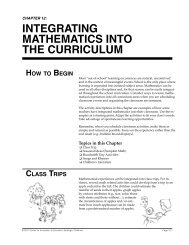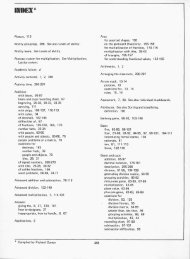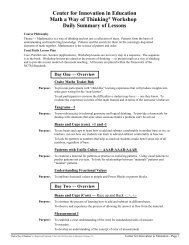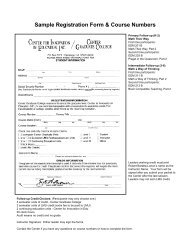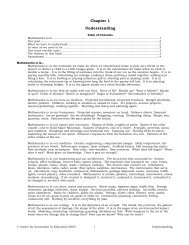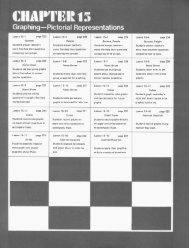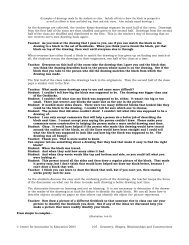PLACE VALUE MAtEriALs - Center for Innovation in Education
PLACE VALUE MAtEriALs - Center for Innovation in Education
PLACE VALUE MAtEriALs - Center for Innovation in Education
Create successful ePaper yourself
Turn your PDF publications into a flip-book with our unique Google optimized e-Paper software.
CHAPTER 11:Mathematics Their Way Summary Newsletter<strong>PLACE</strong> <strong>VALUE</strong>IntroductionA firm under stand <strong>in</strong>g of place value is a pre req ui site <strong>for</strong> all work<strong>in</strong> arith me tic. Stu dents who do not under stand the con cept of placevalue can not progress through the four basic oper ations with outdif fi culty. They “learn” the oper ations by memoriz <strong>in</strong>g an <strong>in</strong>creas<strong>in</strong>gnumber of seem<strong>in</strong>gly unrelated facts and pro ce dures. Even themost capa ble stu dents be come con fused when the load becomestoo great, usu ally at the po<strong>in</strong>t when they must learn mul ti pli ca tionand divi sion. Math e mat ics becomes <strong>in</strong>creas<strong>in</strong>gly mys te ri ous <strong>for</strong>these stu dents, who have lit tle hope of under stand <strong>in</strong>g the con tentof sec ond ary-level math e mat ics courses. It is essen tial that placevalue be given major empha sis <strong>in</strong> the pri mary grades and that studentshave fre quent expe ri ences with manip u la tive mate rials thatdem on strate place value.1985 Cali<strong>for</strong>nia Math e mat ics Framework, p.23In order to effectively implement the place value objec tives outl<strong>in</strong>ed<strong>in</strong> the 1985 Cali<strong>for</strong>nia Mathematics Framework (above) <strong>in</strong> the pri marygrades, the mathe matics curriculum must <strong>in</strong>clude place value experiencesthat:o use developmentally appropriate manipu latives.o use a variety of bases to teach the place value sys tem.o explore place value patterns (l<strong>in</strong>ear and matrix).o provide regroup<strong>in</strong>g and non-regroup<strong>in</strong>g multi-digit addition andsubtraction experi ences simultaneously.© 2011 <strong>Center</strong> <strong>for</strong> <strong>Innovation</strong> <strong>in</strong> <strong>Education</strong>, Saratoga, Cali<strong>for</strong>niaPage 11.1
Chapter 11: Place ValuePlace Value ManiPULA tivesPlace value manipulatives fall with<strong>in</strong> two dis t<strong>in</strong>ct de velopmentallevels: concrete and rep resentational. Con crete place value experiencesmust come first. Representa tional activities are appropriate later <strong>in</strong> theelementary grades — after children have engaged <strong>in</strong> a variety of experienceswith concrete materials.Concrete MaterialsConcrete materials — beans and cups and Unifix cubes — allow thechildren to construct group<strong>in</strong>gs. Experiences with these materialsstress one-to-one correspondence be tween the number and the materialit represents.Kathy Richardson addresses the issue of one-to-one corre spondenceat the place value level <strong>in</strong> her book, De velop<strong>in</strong>g Number Concepts Us <strong>in</strong>gUnifix Cubes (Chapter 5, p. 133):Count<strong>in</strong>g groups [of objects] requires a dif ferent k<strong>in</strong>d of th<strong>in</strong>k<strong>in</strong>gfrom count<strong>in</strong>g s<strong>in</strong> gle objects. Children’s first count<strong>in</strong>g experiencesrequire an understand<strong>in</strong>g of one-to-one correspondence.They learn that one num ber word goes with one object. But,when deal<strong>in</strong>g with numbers above ten, children are requiredto count groups as though they were <strong>in</strong>dividual objects. Thequestion “How many tens <strong>in</strong> thirty-four?” as sumes the child canconceive of ten objects as one en tity. The question “How manyhundreds <strong>in</strong> 346?” as sumes the child can conceive of one hundredob jects as one group (all the while remem ber<strong>in</strong>g that eachhundred is also ten groups of ten).Representational MaterialsBean sticks and multi-base blocks are “fixed” materials. The materialsimpose a ready-made structure on the stu dent. Although childrenmanipulate materials — e.g., chips, multi-base blocks and bean sticks— they are re quired to th<strong>in</strong>k abstractly. A child with <strong>in</strong>suffi cient experiencesus<strong>in</strong>g concrete materials may be confused when a numberis represented by multi-base blocks. They must already under standthat one block <strong>in</strong> base ten represents ei ther ten flats, a hundred longs,or a thousand units. Rather than understand<strong>in</strong>g that a num ber like362 is rep resented by three flats, six longs, and two units, a child mayonly see eleven separate blocks of vary<strong>in</strong>g sizes.Chip trad<strong>in</strong>g is also representational but at a more ab stract level.Children must be able to understand the “abstraction” that one chipcould represent a group of ten or a hundred chips (chips can alsorepresent group<strong>in</strong>gs <strong>in</strong> other bases). The necessity <strong>for</strong> children to besurrounded with an abundance of concrete ex periences be<strong>for</strong>e theymove on to representa tional materials cannot be empha sized stronglyenough.Page 11.2© 2011 <strong>Center</strong> <strong>for</strong> <strong>Innovation</strong> <strong>in</strong> <strong>Education</strong>, Saratoga, Cali<strong>for</strong>nia
Mathematics Their Way Summary NewsletterChoose AppropriateManipulatives© 2011 <strong>Center</strong> <strong>for</strong> <strong>Innovation</strong> <strong>in</strong> <strong>Education</strong>, Saratoga, Cali<strong>for</strong>niaBecause mathematics is made by human be<strong>in</strong>gs and exists only<strong>in</strong> their m<strong>in</strong>ds, it must be made and re made <strong>in</strong> the m<strong>in</strong>d of eachperson who learns it. In this sense mathematics can only belearned by be<strong>in</strong>g created.Author UnknownTeachers often overlook the limitations set by represen tational materials.One Math Their Way teacher told how she made bean sticks withher second grade class one year. The class had experienced place valueactivities earlier <strong>in</strong> the school year and <strong>in</strong> the first grade, us<strong>in</strong>g con cretematerials. Once the sticks and rafts were con structed, the children usedthem to make addition and subtraction problems. The children lovedthe bean sticks. They didn’t ap pear to have any problems with the“fixed ar rangement” of the sticks and rafts.The teacher kept the bean sticks and used them with classes after thatyear. The new second graders didn’t seem to relate to the materials <strong>in</strong>the same manner as the first group. In retrospect, the teacher felt thereason the bean sticks were more successful the first year was becausethe children participated <strong>in</strong> the construction of the sticks and rafts.They un derstood what the beans on the sticks and rafts represented.Even though they had similar classroom experiences to prepare them<strong>for</strong> the activity, the children who used the pre-assem bled materials thefollow<strong>in</strong>g years didn’t expe rience the creation of the sticks and rafts.The pre-assembled (representational) materials “imposed a structure”that subsequent classes of second grade children were not ready toac cept.Be careful not to move prematurely to the rep resentational level. Allowchildren time to construct their own understand<strong>in</strong>g of place value byengag<strong>in</strong>g <strong>in</strong> experiences with an as sortment of concrete place valuematerials.Page 11.3
Chapter 11: Place ValueUse a variety of basesPlace value is merely a system of organiz<strong>in</strong>g large numbers. Teacherstend to th<strong>in</strong>k that the base ten system is the only base we use <strong>in</strong> thereal world. For this reason, they often question why other bases aretaught <strong>in</strong> the lower grades. It’s true that our society frequently usesbase ten, but we also use other bases every day without th<strong>in</strong>k<strong>in</strong>g aboutit. Every time we bake, sew, measure with a ruler, or tell time, we arework<strong>in</strong>g with other bases. The com puter oper ates on a b<strong>in</strong>ary systemor base two. Yet, text books tend to teach isolated place value skills(e.g., bor row<strong>in</strong>g and carry<strong>in</strong>g) <strong>in</strong> base ten only. Children will de velopa better understand<strong>in</strong>g of place value if they are allowed opportunitiesto compare and contrast relation ships (us<strong>in</strong>g real materials and reallifeexperiences) <strong>in</strong> other bases.TEACH Regroup<strong>in</strong>g and non-regroup<strong>in</strong>g addition andsubtraction TOGETHERThe 1985 Cali<strong>for</strong>nia Mathematics Framework, p. 22, em phasizes theimportance of teach<strong>in</strong>g multi-digit addition and subtraction <strong>in</strong> a waythat students understand the process, rather than view<strong>in</strong>g each algorithmas a separate, iso lated function:The practice of a skill <strong>in</strong> isolation is sel dom effec tive <strong>in</strong> develop<strong>in</strong>gthe under stand<strong>in</strong>g required to make the skill useful. Instruction <strong>in</strong>computational algorithms should emphasize under stand <strong>in</strong>g thepro ce dures that are be<strong>in</strong>g used.For exam ple, it is now com mon to teach two-place addi tion andsub trac tion with out regroup<strong>in</strong>g be<strong>for</strong>e <strong>in</strong>tro duc <strong>in</strong>g re group<strong>in</strong>g.This approach leads stu dents to focus on sep a rate pro ce dures andh<strong>in</strong> ders their under stand <strong>in</strong>g of the basic oper ations. Most stu dents43view a prob lem such as +25 as two one-place prob lems pushedtogether ( 4 and 3 ) and do not th<strong>in</strong>k of add<strong>in</strong>g 40 and 20.+2+5Because students get a great deal of prac tice <strong>in</strong> this k<strong>in</strong>d of problem,they assume that43+29 can be cal cu lated <strong>in</strong> the same way andsee noth<strong>in</strong>g wrong with the answer of 612. After learn <strong>in</strong>g a newpro ce dure <strong>in</strong> which 1 is car ried or put on top of the ten’s col umnevery time, stu dents are con fused when pre sented with a mix tureof prob lems that re quire regroup<strong>in</strong>g and prob lems that do not.The child who asks, “Do I regroup on this prob lem?” has al mostno under stand <strong>in</strong>g of the con cept of two-digit addi tion or sub traction.This dilemma can be avoided by teach <strong>in</strong>g multi-digit additionand sub trac tion with and with out regroup<strong>in</strong>g si multaneously,us<strong>in</strong>g manip u la tive place value mate rials, and relat <strong>in</strong>g the proc essto real is tic sit u ations. When manip u la tive mate rials are used, it iseasy to dem on strate when regroup<strong>in</strong>g is needed; and there is noneed to teach regroup<strong>in</strong>g as a sep a rate algo rithm.Page 11.4© 2011 <strong>Center</strong> <strong>for</strong> <strong>Innovation</strong> <strong>in</strong> <strong>Education</strong>, Saratoga, Cali<strong>for</strong>nia
EMPHASIZE THE IMPORTANCE OF patternsMathematics Their Way Summary NewsletterChildren should have opportunities to explore both l<strong>in</strong> ear and matrixplace value patterns <strong>in</strong> a variety of bases. An understand<strong>in</strong>g of patternsencourages children to see relationships between the parts andthe whole. An under stand<strong>in</strong>g of the process develops from experienc<strong>in</strong>gnumerous patterns <strong>in</strong> different bases. Bob Baratta-Lorton wrote<strong>in</strong> Math e mat ics...A Way of Th<strong>in</strong>k <strong>in</strong>g, p. 81:When stu dents search <strong>for</strong> pat terns <strong>in</strong> group <strong>in</strong>gs of three, four, andfive, and they then see these same pat terns re peat <strong>for</strong> group <strong>in</strong>gsof ten, they achieve a far greater under stand <strong>in</strong>g of borrow<strong>in</strong>g andcar ry <strong>in</strong>g than is pos si ble from stud y <strong>in</strong>g base ten <strong>in</strong> iso la tion.© 2011 <strong>Center</strong> <strong>for</strong> <strong>Innovation</strong> <strong>in</strong> <strong>Education</strong>, Saratoga, Cali<strong>for</strong>niaPage 11.5
Chapter 11: Place ValuePlace Value ScheduleChoose the activities that best fit your class’s needs. In general, theplace value focus <strong>for</strong> each grade level <strong>in</strong> cludes the follow<strong>in</strong>g:K<strong>in</strong>dergartenK<strong>in</strong>dergartners do not <strong>for</strong>mally explore place value con cepts. They areexposed to the place value board and the notion of organiz<strong>in</strong>g largenumbers of objects <strong>in</strong>to groups of ten through the follow<strong>in</strong>g types ofactivi ties:o Estimat<strong>in</strong>g and count<strong>in</strong>g groups of objects <strong>in</strong> conta<strong>in</strong>ers (see NL,Measurement pp. 7.12 - 7.15). The place value board is used whenthe objects are counted and grouped <strong>in</strong>to ten's.o Open<strong>in</strong>g activities, NL Chapter 4 (e.g., Straw Count, Tally Count,Number L<strong>in</strong>e).First GradePlace value concepts are <strong>for</strong>mally <strong>in</strong>troduced and ex plored at the conceptand connect<strong>in</strong>g levels late <strong>in</strong> the school year.o Estimat<strong>in</strong>g and count<strong>in</strong>g groups of objects <strong>in</strong> conta<strong>in</strong>ers (see NL,pp. 7.12 - 7.15). The place value board is used when the objects arecounted and grouped <strong>in</strong>to ten's.o Open<strong>in</strong>g activities, (e.g., Straw Count, Tally Count, Number L<strong>in</strong>e).o Place value activities us<strong>in</strong>g other bases (concept and connect<strong>in</strong>glevel).o Base ten station activities (concept level — record<strong>in</strong>g is not necessary).Second GradePlace value is the ma<strong>in</strong> focus of second grade mathemat ics. Secondgraders explore all levels of place value throughout the school year.o Estimat<strong>in</strong>g and count<strong>in</strong>g groups of objects <strong>in</strong> conta<strong>in</strong>ers. The placevalue board is used when the objects are counted and grouped <strong>in</strong>toten's.o Open<strong>in</strong>g Activities, (e.g., Straw Count, Tally Count, Number L<strong>in</strong>e).o All place value activities us<strong>in</strong>g other bases (concept and connect<strong>in</strong>gand symbolic level).o All base ten activities (station and <strong>in</strong>dependent).Page 11.6© 2011 <strong>Center</strong> <strong>for</strong> <strong>Innovation</strong> <strong>in</strong> <strong>Education</strong>, Saratoga, Cali<strong>for</strong>nia
Mathematics Their Way Summary NewsletterExplor<strong>in</strong>g Place Value <strong>in</strong> a Varietyof Group<strong>in</strong>gsThe <strong>in</strong>itial place value activities <strong>in</strong> this section pro vide children aframework <strong>for</strong> understand<strong>in</strong>g place value while add<strong>in</strong>g and subtract<strong>in</strong>g<strong>in</strong> different group <strong>in</strong>gs. Children acquire a better understand<strong>in</strong>g ofthe process of regroup<strong>in</strong>g (borrow<strong>in</strong>g and carry<strong>in</strong>g) when they haveex periences with group<strong>in</strong>gs of four, five, and six — as well as with baseten. Independent base ten activities are <strong>in</strong>troduced once the childrendemonstrate a clear understand<strong>in</strong>g of the place value process. The urgeto focus on base ten too quickly should be resisted.© 2011 <strong>Center</strong> <strong>for</strong> <strong>Innovation</strong> <strong>in</strong> <strong>Education</strong>, Saratoga, Cali<strong>for</strong>niaEach group<strong>in</strong>g used (except base ten) is given a nonsense name. Thechildren are asked <strong>for</strong> suggestions. The nonsense name <strong>for</strong> each group<strong>in</strong>grema<strong>in</strong>s the same <strong>for</strong> the re ma<strong>in</strong>der of the year. A class chart ofthe non sense names is displayed. Each group<strong>in</strong>g name is added to thechart after it is <strong>in</strong>troduced through the Count<strong>in</strong>g Game.Concept Level: GROUP ACTIVITIESSearch<strong>in</strong>g <strong>for</strong> PatternsCount<strong>in</strong>g Game (MTW, pp. 98-99)Practice count<strong>in</strong>g by the group<strong>in</strong>gs us<strong>in</strong>g the nonsense word.Class CountChoose a nonsense name <strong>for</strong> the group<strong>in</strong>g to be experi enced.(“Zurkles” will be used <strong>in</strong>stead of four <strong>in</strong> this de scription). Ask theclass to stand up and count off by the group<strong>in</strong>g chosen. Each personwho says the nonsense word must sit down (e.g.,. “One, two, three,zurkle ... one, two, three, zurkle...”). The game cont<strong>in</strong>ues until oneper son rema<strong>in</strong>s stand<strong>in</strong>g.When half the class rema<strong>in</strong>s stand<strong>in</strong>g, ask the chil dren if they canpredict who will be the last person stand<strong>in</strong>g.Group CountOnce the rules are established, split the class <strong>in</strong>to small groups. Askthem to count off <strong>in</strong> their groups. Use the follow<strong>in</strong>g questions to challengethe groups:o Pre dict who will be the last per son stand <strong>in</strong>g.o Does it make a dif fer ence where you start count <strong>in</strong>g?o If you start with the same per son twice, will the last per son stand<strong>in</strong>gbe the same twice? Why? Why not?o Start with the per son stand <strong>in</strong>g to the right (left) of the first starter.Pre dict who will be the last per son stand <strong>in</strong>g.o Add a per son to the cir cle. Pre dict who will be the last personstand <strong>in</strong>g. Cont<strong>in</strong>ue add<strong>in</strong>g a person; is a pattern develop<strong>in</strong>g?o Count <strong>in</strong> another group<strong>in</strong>g. Do you th<strong>in</strong>k the outcome will be thesame? If not, can you predict who will be the last person stand<strong>in</strong>g?Page 11.7
Chapter 11: Place ValueNote: Mathematics Their Way, (Ch.12) says to read amount of materialson the place value board with“and” (two zurkles and three).This is mathematically <strong>in</strong>-correct.“And” signifies a decimal po<strong>in</strong>t.The correct way to read the amountis “two zurkles, three.”Introduce Addition and Subtraction on thePlace Value BoardMaterials: Place value boards (MTW, p. 364); manipula tive materials(e.g., Unifix cubes or beans and portion cups)Be<strong>for</strong>e beg<strong>in</strong>n<strong>in</strong>g: Review how to use the place value board. The group<strong>in</strong>gs(e.g., Zurkles) are placed on the blue side and the one's are placedon the white side. If the children use Unifix cubes, they snap the cubestogether <strong>in</strong>to a stick be<strong>for</strong>e they place them on the blue side. If they usebeans, they place the group<strong>in</strong>g of beans <strong>in</strong> a cup and move the cup tothe blue side.Addition: Beg<strong>in</strong> by add<strong>in</strong>g one object. Expla<strong>in</strong> to the children that eachtime you say “plus one”, they add a cube (or bean) to their place valueboard. Once the mate rial is added to the board, the whole class saysthe number. The group cont<strong>in</strong>ues to add to the largest two-digit numberpossible, regroup<strong>in</strong>g whenever necessary. For <strong>in</strong>stance, <strong>in</strong> zurkles(group<strong>in</strong>gs of four), the largest number would be three zurkles andthree.Subtraction: Start with the largest two-digit number pos sible <strong>in</strong> thegroup<strong>in</strong>g. Ask the children to subtract one object at a time until theyreach zero — regroup<strong>in</strong>g when ever necessary.Extension: Add or subtract by two or three objects at a time.Random PracticeIt is important that children have opportunities to ran domly addand subtract.Build <strong>in</strong>g NumbersMaterials: Beans and cups or Unifix cubes; place value boardTell the children a number to build on the place value board (e.g.,2 zurkles, three). Then tell them a new number (e.g., 3 zurkles, 2).The children build the new number on the place value board withmaterials. Repeat the process several times.Observation: Observe how the children f<strong>in</strong>d their an swers. Do somechil dren clear their boards every time they build a new number? Doothers add on or sub tract the appro pri ate objects? Ask the childrento expla<strong>in</strong> how they made the new number. Ask the children if theyth<strong>in</strong>k the new number is larger or smaller than the previous number.Ask them to expla<strong>in</strong> their answer.Add or Sub tractTell the children a number to build on their place value board. Nowask them to add or sub tract a cer ta<strong>in</strong> number of beans.Observation: Watch to see if the children can regroup when it isnecessary.Page 11.8© 2011 <strong>Center</strong> <strong>for</strong> <strong>Innovation</strong> <strong>in</strong> <strong>Education</strong>, Saratoga, Cali<strong>for</strong>nia
Mathematics Their Way Summary NewsletterConnect<strong>in</strong>g Level: GROUP ACTIVITiESThe goal of follow<strong>in</strong>g activities is to acqua<strong>in</strong>t the chil dren with thewritten symbol that represents the number on the place value board.The class repeats the addition and subtraction activities <strong>in</strong>troduced atthe concept level. This time the teacher records the numerical patternsei ther on a long strip or <strong>in</strong> a matrix frame, as the children add andsubtract the materials on the place value board.Search<strong>in</strong>g <strong>for</strong> PatternsVertical PatternsMaterials: Place value boards (MTW, p. 364); add<strong>in</strong>g ma ch<strong>in</strong>e tape;manipulative materials (Unifix cubes or beans and portion cups)Procedure: After the numerical patterns are recorded on the strip, theclass searches <strong>for</strong> patterns and then <strong>in</strong>ter prets the patterns <strong>in</strong> eachcolumn. Ask the children to look <strong>for</strong> a pattern <strong>in</strong> the blue column.Then ask them to alter nate stand<strong>in</strong>g and sitt<strong>in</strong>g each time the patternsequence changes as they read the patterns <strong>in</strong> unison. Loop the patternsas the children <strong>in</strong>terpret each pattern.Ask the children to look <strong>for</strong> patterns <strong>in</strong> the right column (pla<strong>in</strong> side).This time, ask the children to stamp their foot each time a zero is read.Loop the repeat<strong>in</strong>g sequence as the children <strong>in</strong>terpret the pattern.Extension:o Repeat the number strip activities <strong>for</strong> different count <strong>in</strong>g sequences(by one’s, two’s, three’s,…) <strong>in</strong> one group<strong>in</strong>g. Cont<strong>in</strong>ue to search <strong>for</strong>patterns <strong>in</strong> the one’s and cup’s col umn until the whole count<strong>in</strong>gsequence beg<strong>in</strong>s to re peat. How many numbers did you have tocount be<strong>for</strong>e this occurred? Is there a pattern?o Repeat the activities <strong>in</strong> a variety of group<strong>in</strong>gs.Matrix PatternsMaterials: Place value boards (MTW, p. 364); class size matrix grid;crayons; manipulative ma terials (Unifix cubes or beans and portioncups)Chil dren should have opportunities to search <strong>for</strong> pat terns on matricesas well as number strips. Encourage the chil dren to com pare thematrix patterns and make pre dictions from the var i ous pat terns.Procedure: The teacher records on a matrix grid the same size as thebase (e.g., base 4 would be a 4 box by 4 box grid) <strong>in</strong>stead of a numberstrip. The class searches <strong>for</strong> patterns after the sequence is recorded.The teacher loops and shades the patterns with crayons as the childrendis cover the patterns.Extension:o Repeat the matrix activity <strong>for</strong> different count<strong>in</strong>g se quences (byone’s, two’s, three’s,…)o Change the size of the matrix grid (e.g., from a 4 box by 4 box matrixto a 5 box by 5 box matrix).© 2011 <strong>Center</strong> <strong>for</strong> <strong>Innovation</strong> <strong>in</strong> <strong>Education</strong>, Saratoga, Cali<strong>for</strong>niaPage 11.9
Chapter 11: Place ValueCompar<strong>in</strong>g Patterns on the Matrices andNumber StripsAfter the teacher has recorded a variety of sequences on matrix gridsand number strips, the class compares, dis cusses and makes predictionsus<strong>in</strong>g the <strong>in</strong><strong>for</strong>mation.o Compare different count<strong>in</strong>g sequences (by one’s, two’s, three’s,…)<strong>in</strong> one group<strong>in</strong>g on number strips.o Compare different count<strong>in</strong>g sequences (by one’s, two’s, three’s,…)<strong>in</strong> one group<strong>in</strong>g on matrix grids.o Compare a count<strong>in</strong>g sequence <strong>in</strong> different group<strong>in</strong>gs on the numberstrips.o Compare patterns of a count<strong>in</strong>g sequence recorded on a matrix gridand a number strip.o The teacher records the count<strong>in</strong>g sequence <strong>in</strong> a differ ent size matrixgrid. The class searches <strong>for</strong> patterns <strong>in</strong> the new grid and then comparesthe two grids.o The teacher records different group<strong>in</strong>gs <strong>in</strong> the same size matrixgrid.Page 11.10© 2011 <strong>Center</strong> <strong>for</strong> <strong>Innovation</strong> <strong>in</strong> <strong>Education</strong>, Saratoga, Cali<strong>for</strong>nia
Random PracticeMathematics Their Way Summary NewsletterPlace Value Number FlipsMaterials: Place value boards; place value number flips (MTW, p. 363);manipulative materi als (Unifix cubes or beans and portion cups)Show the children how to attach the number flips to their place valueboards. Only the numbers used <strong>in</strong> the base be<strong>in</strong>g used are on top of theplace value board. All the other numbers are tucked <strong>in</strong>to the pocket onthe back of the board.Build <strong>in</strong>g NumbersTell the chil dren a number to make with the place value number flips.Then ask them to build that number on the place value boards withmate rials (either beans and cups or Unifix cubes). Repeat the proc esswith a dif fer ent number.Add and SubtractAsk the children to make a two-digit numeral with their place valuenumber flips. Then ask them to build the number on their place valueboards with materials. Now ask them to add or sub tract a cer ta<strong>in</strong>number of objects. Once they have added or removed the designatednumber of materi als, ask them to change the place value number flipsto represent the new quantity of objects.Connect<strong>in</strong>g Level: Independent ActivitiesRandom PracticeMaterials needed <strong>for</strong> each child: portion cups; beans; bowl; place valueboard; 1-3 diceThe follow<strong>in</strong>g activities can be played <strong>in</strong> any group<strong>in</strong>g. Wooden cubescan be used to make the dice. Some teachers choose to make a differentset of dice <strong>for</strong> base 4, 5, and 6. Other teachers make a set of base 6 dice(numbered zero to five). When they play the game <strong>in</strong> group<strong>in</strong>gs of 4 or5, they cover the <strong>in</strong>appropriate numbers with a gummed la bel. If thechildren roll a blank side when play<strong>in</strong>g the games <strong>in</strong> either group<strong>in</strong>gs of4 or 5, they repeat the num ber they previously rolled.The children work <strong>in</strong> pairs. They take turns roll<strong>in</strong>g the dice and build<strong>in</strong>gthe material on the place value board.Dice ArrangementNote: Be<strong>for</strong>e the game beg<strong>in</strong>s, the players must decide how the w<strong>in</strong>nerwill be determ<strong>in</strong>ed: either the smallest or largest number.Procedure: The first per son rolls two dice. He or she ar ranges the dice tomake the larg est (or smallest) number pos si ble. Then the person buildsthe number with beans on his or her place value board. The sec ondchild rolls the dice and builds the number with beans and cups on his orher place value board.Once the numbers are built on the place value board, the chil dren comparetheir numbers to deter m<strong>in</strong>e which number is larg er (or smaller).Extension: For children who may need to be chal lenged, give them threedice to arrange.© 2011 <strong>Center</strong> <strong>for</strong> <strong>Innovation</strong> <strong>in</strong> <strong>Education</strong>, Saratoga, Cali<strong>for</strong>niaPage 11.11
Chapter 11: Place ValueRace to a BowlNote: Be<strong>for</strong>e the game beg<strong>in</strong>s, the part ners decide how the w<strong>in</strong> ner willbe determ<strong>in</strong>ed: either the first per son to reach the bowl col umn or thelast per son to reach the bowl column.Procedure: The players start with empty place value boards. Each playerwill take a turn roll<strong>in</strong>g the die and add <strong>in</strong>g that number of beans tohis or her place value board. The players con t<strong>in</strong>ue roll<strong>in</strong>g the die andadd <strong>in</strong>g beans to the place value board until the first per son reaches thebowl col umn.Race to ZeroNote: Be<strong>for</strong>e the game beg<strong>in</strong>s, the players must decide who the w<strong>in</strong> nerwill be: either the first per son to reach 0 or the last per son to reach 0.Procedure: Start with the bowl col umn filled (e.g. <strong>in</strong> Zurkles, the bowlwould con ta<strong>in</strong> four cups with four beans <strong>in</strong> each cup). The players taketurns roll<strong>in</strong>g the die and subtract<strong>in</strong>g the beans until one player reacheszero. Sometimes the children add the rule that the exact num ber mustbe rolled on the last roll.Observation: Watch how the children regroup the first time they takethe beans away.Page 11.12© 2011 <strong>Center</strong> <strong>for</strong> <strong>Innovation</strong> <strong>in</strong> <strong>Education</strong>, Saratoga, Cali<strong>for</strong>nia
Symbolic Level: Independent ActivitiesSearch<strong>in</strong>g <strong>for</strong> PatternsMathematics Their Way Summary NewsletterVertical PatternsMaterials needed <strong>for</strong> each child: Place value strips (NL Blackl<strong>in</strong>e #47);beans; portion cups; 2-3 small envelopes; a large plastic zip pered bag;clothesp<strong>in</strong>; 3 dice with numerals <strong>in</strong> the predeterm<strong>in</strong>ed group<strong>in</strong>gThe class works together at this activity when it is first <strong>in</strong>troduced.They decide which group<strong>in</strong>g (e.g., Zurkle) to use. To determ<strong>in</strong>e howfar to add or which number to start subtract<strong>in</strong>g from, three dice arerolled and arranged <strong>in</strong>to a three-digit num ber.This process may take more than one day. When the child f<strong>in</strong>ishes<strong>for</strong> the day, he or she rolls up the place value strip and clips it with aclothesp<strong>in</strong>. The place value strip, place value board, portion cups, andenvelopes of beans are stored <strong>in</strong> a large zippered plastic bag with thechild's name on it. The next day the child builds the last number onthe place value strip and cont<strong>in</strong>ues: add<strong>in</strong>g or subtract<strong>in</strong>g materialson the place value board; record<strong>in</strong>g the numerals on the place valuestrip; and loop<strong>in</strong>g the patterns <strong>in</strong> each column.Addition Procedure: The class works at this activity to gether when itis first <strong>in</strong>troduced. They add materials on their place value board andrecord the numerals together to the end of the first strip. Then, eachchild loops the patterns <strong>in</strong> each column on his or her strip and attachesa new place value strip. The class works together <strong>for</strong> approximatelytwo and a half strips. Then they cont<strong>in</strong>ue work<strong>in</strong>g at their own paceun til they reach the number predeterm<strong>in</strong>ed by the dice roll. When thechild has added to the third column, the beans <strong>in</strong> the portion cups areplaced <strong>in</strong> an envelope and sealed.Subtraction Procedure: The children beg<strong>in</strong> by build<strong>in</strong>g the numberdeterm<strong>in</strong>ed by the dice with materials on their place value board. Theobjects <strong>for</strong> the third column are put <strong>in</strong> envelopes and placed to theleft of the cups column. Then the children record the number at thetop of their place value strips. Next, they subtract one object at a timeand record the number on their place value strips. When they havecompleted one strip, each child loops the patterns <strong>in</strong> each column ofthe place value strip and attaches a new strip. The class works together<strong>for</strong> approximately two and a half strips. The children cont<strong>in</strong>uework<strong>in</strong>g at their own pace un til they reach zero. When the child subtractsall the objects <strong>in</strong> the cups and units columns of the place valueboard, he or she opens an envelope of objects <strong>in</strong> the third column andregroups them <strong>in</strong> portion cups be<strong>for</strong>e cont<strong>in</strong>u<strong>in</strong>g to subtract.Note: Pattern is a self-correct<strong>in</strong>g tool and whenever a child f<strong>in</strong>ds anerror, rather than eras<strong>in</strong>g, the child merely cuts off the place valuestrip where the er ror occurred and attaches a new strip.Do not be surprised about how many children <strong>for</strong>get to write <strong>in</strong> thenumbers at the regroup<strong>in</strong>g stage. This error corrects itself as soon asthe children realize the value of pattern. They beg<strong>in</strong> to f<strong>in</strong>d their mistakesby look<strong>in</strong>g <strong>for</strong> the recorded evolv<strong>in</strong>g pat terns.Extension: Ask the children to search <strong>for</strong> patterns while add<strong>in</strong>g orsubtract<strong>in</strong>g by two (or three) objects each time.© 2011 <strong>Center</strong> <strong>for</strong> <strong>Innovation</strong> <strong>in</strong> <strong>Education</strong>, Saratoga, Cali<strong>for</strong>niaPage 11.13
Chapter 11: Place ValueMatrix PatternsMaterials needed <strong>for</strong> each child: matrix frames of various sizes (NL Blackl<strong>in</strong>e#46); materials to count; portion cups; place value board; coloredpencils, crayons, or markers to loop patternsSame Group<strong>in</strong>g — Different Size FramesThe children can work <strong>in</strong> partners or alone. They beg<strong>in</strong> by add<strong>in</strong>g objectsto the place value board one at a time and record<strong>in</strong>g the count<strong>in</strong>gsequence <strong>for</strong> the chosen group<strong>in</strong>g <strong>in</strong> the matrix frame. They record thenumerals <strong>in</strong> sequence until the matrix frame is filled.Extensions:o When the children are experienced with record<strong>in</strong>g <strong>in</strong> a matrixframe, they can record one numeral at a time until they beg<strong>in</strong> to seepatterns develop<strong>in</strong>g <strong>in</strong> the columns and rows (vertically, horizontallyand diagonally). They complete the matrix by record<strong>in</strong>g thepatterns as they discover them. If they’re unsure of a pattern, theycan check it by us<strong>in</strong>g concrete materials.o Once one matrix has been completed, the children can try a differentsize matrix frame. Some of the patterns <strong>in</strong> the first matrix maybe useful when the children predict patterns <strong>in</strong> the new frame.o The children can record patterns by add<strong>in</strong>g by two or three numbersat a time. Concrete materials can be used to con firm the matrixpatterns.Same Size Frame — Different Group<strong>in</strong>gsThe pair chooses a matrix frame (e.g., 5 boxes by 5 boxes) and agroup<strong>in</strong>g. They record until they beg<strong>in</strong> to see pat terns develop<strong>in</strong>g <strong>in</strong>the columns and rows (vertically, hor izontally and diagonally). Theyrecord the matrix patterns as they are discovered. When the frame iscom pleted, the pair searches <strong>for</strong> additional patterns. They loop and/orshade patterns with the side of a crayon.When the pair is f<strong>in</strong>ished search<strong>in</strong>g <strong>for</strong> patterns <strong>in</strong> the first group<strong>in</strong>g,they choose a different group<strong>in</strong>g and record it <strong>in</strong> the same size frame.They compare the patterns <strong>in</strong> the two group<strong>in</strong>gs <strong>in</strong> the same matrixgrids.Page 11.14© 2011 <strong>Center</strong> <strong>for</strong> <strong>Innovation</strong> <strong>in</strong> <strong>Education</strong>, Saratoga, Cali<strong>for</strong>nia
Mathematics Their Way Summary NewsletterBase Ten WorkGroup ActivitiesSearch<strong>in</strong>g <strong>for</strong> PatternsMaterials: class-size (10 by 10) matrix frame or overhead transparencyof NL Blackl<strong>in</strong>e #45; class-size hundred's chart or an overhead transparencyof NL Blackl<strong>in</strong>e #44Search<strong>in</strong>g <strong>for</strong> Patterns on the Hundred’s ChartProcedure: Record the count<strong>in</strong>g sequence on a class-size 10 by 10matrix frame as the children count by one's. Complete approximatelyone and one-half rows <strong>in</strong> sequence be<strong>for</strong>e ask<strong>in</strong>g the children if theysee any patterns develop<strong>in</strong>g (vertically, horizontally or diagonally).Complete the matrix as the children discover the patterns.Extensions:o Us<strong>in</strong>g the same procedure, the class searches <strong>for</strong> patterns <strong>in</strong> othercount<strong>in</strong>g sequences (by two's, three's, five's…) as you record thepattern sequences on a large class-size (10 by 10) frame.o The class searches <strong>for</strong> patterns while subtract<strong>in</strong>g. Beg<strong>in</strong> the activityby record<strong>in</strong>g 100 <strong>in</strong> the first box. The class counts backward,one number at a time, as you record the numerals on the matrix.Complete approximately one and one-half rows. Ask the childrento search <strong>for</strong> patterns. Record the patterns as the children discoverthem.o A completed class-size hundred’s chart is used <strong>for</strong> this activity. Askthe children to search <strong>for</strong> pattern sequences. Ask the children if theysee the same sequence anywhere else on the chart. Loop and/orshade the patterns with a colored marker or crayon. Ask the childrento search <strong>for</strong> a different pattern sequence. Cont<strong>in</strong>ue to search<strong>for</strong> patterns <strong>in</strong> this fashion.Random PracticeVisualizationAfter the children have had extensive manipulative ex periencesregroup<strong>in</strong>g while add<strong>in</strong>g and subtract<strong>in</strong>g large numbers <strong>in</strong> base ten,allow some time <strong>for</strong> the children to visualize the re group<strong>in</strong>g process.Visualization enables children to tran sition from their concrete experiencesto a more abstract level. This is necessary <strong>for</strong> them to be successful<strong>in</strong> school test<strong>in</strong>g situations.Procedure: Write a problem on the board. Ask the children to closetheir eyes and imag<strong>in</strong>e a certa<strong>in</strong> type of manipulative on the placevalue board as the teacher records the action numerically. The childrenshould expe rience visualiz<strong>in</strong>g both addition and subtraction equations.© 2011 <strong>Center</strong> <strong>for</strong> <strong>Innovation</strong> <strong>in</strong> <strong>Education</strong>, Saratoga, Cali<strong>for</strong>niaPage 11.15
Chapter 11: Place ValueSample Teach<strong>in</strong>g Strategy —VisualizationPage 11.16© 2011 <strong>Center</strong> <strong>for</strong> <strong>Innovation</strong> <strong>in</strong> <strong>Education</strong>, Saratoga, Cali<strong>for</strong>nia
Mathematics Their Way Summary NewsletterIndependent ActivitiesSearch<strong>in</strong>g <strong>for</strong> PatternsBe<strong>for</strong>e You Beg<strong>in</strong>: Run off NL blackl<strong>in</strong>e #43 <strong>for</strong> each child. The masterhas two rows with five stars <strong>in</strong> each row.Place a copy of the star blackl<strong>in</strong>e on the one’s side of each child’s placevalue board. It is difficult to tell at a glance (without count<strong>in</strong>g) howmany counters are on the board <strong>in</strong> base ten. The stars give the childan organiz<strong>in</strong>g tool <strong>for</strong> work <strong>in</strong> base 10. By cover<strong>in</strong>g each star with thematerial, children will th<strong>in</strong>k <strong>in</strong> terms of number comb<strong>in</strong>ations. Withoutthe addition of the star work<strong>in</strong>g area, they may count by ones and missthe opportunity to re<strong>in</strong><strong>for</strong>ce the addition and subtraction comb<strong>in</strong>ations.Vertical PatternsMaterials needed <strong>for</strong> each child: Place value strips (NL Blackl<strong>in</strong>e #47); asmall cyl<strong>in</strong>der made of tagboard; a clothesp<strong>in</strong>; beans; 10 portion cups;2-3 en velopes; large zippered bag (to store the materials)Procedure: The children practice add<strong>in</strong>g to or subtract<strong>in</strong>g from a largethree-digit number <strong>in</strong> base ten. It’s helpful if the children work <strong>in</strong> pairs.Each pair chooses a small conta<strong>in</strong>er from the compar<strong>in</strong>g station andfills it with beans. The beans are placed <strong>in</strong> a zippered bag <strong>for</strong> storage.Addition: The children count by one’s — one person records the sequenceas the other person adds the material to the place value board.They search <strong>for</strong> and loop patterns every time an <strong>in</strong>dividual place valuestrip is completed. Once the patterns are looped and any mistakes aresnipped off, a new place value strip is added and the pair cont<strong>in</strong>uesadd<strong>in</strong>g beans. When they reach 100, they empty the ten cups of beans<strong>in</strong>to an envelope and seal it. The enve lope is placed off the place valueboard (to the left of the 10’s column).Subtraction: This time, the conta<strong>in</strong>er full of beans is grouped <strong>in</strong>to hundred’s,ten’s and one’s. The hundred's are sealed <strong>in</strong> an envelope. Thetotal is recorded at the top of the place value strip. The pair sub tracts(one bean at a time), records, and searches <strong>for</strong> patterns on the numberstrip until they are out of beans.Extension: Children should have experiences add<strong>in</strong>g and subtract<strong>in</strong>gby two, three, four… objects at a time. (see MTW p. 314).Matrix PatternsMaterials needed <strong>for</strong> each child: hundred's chart (NL blackl<strong>in</strong>e #44);blank (10 by 10) matrix frame (NL blackl<strong>in</strong>e #45)Procedure: The children <strong>in</strong>dependently search <strong>for</strong> and record patternson a matrix. See NL, page 11.15 <strong>for</strong> a detailed description.© 2011 <strong>Center</strong> <strong>for</strong> <strong>Innovation</strong> <strong>in</strong> <strong>Education</strong>, Saratoga, Cali<strong>for</strong>niaPage 11.17
Chapter 11: Place ValueRandom PracticeDice GamesPlay Dice Arrangement (NL, p. 11.11), Race to a Bowl (p. 11.12), Race toZero (NL. p. 11.12) <strong>in</strong> base ten.(*) Note: Large place value additionboards can be made with 9" x11" file folders. (see directions p.11.23)Bob’s DittoAdditionMaterials: small objects; portion cups; addition board* (NL Blackl<strong>in</strong>e#39); record<strong>in</strong>g sheet (NL Blackl<strong>in</strong>e #38)Step One: Take a handful of junk andcount it <strong>in</strong>to count <strong>in</strong>g cups. Place thejunk on the top place value boxes of theaddition board. Record the number onthe record<strong>in</strong>g sheet.Step Two: Take another handful andcount it <strong>in</strong>to count <strong>in</strong>g cups. Place thejunk <strong>in</strong> the middle place value boxes.Record the number on the record<strong>in</strong>gsheets.Step Three: Move the junk down to thebottom place value boxes.Step Four: Regroup to f<strong>in</strong>d the total.Record the total on the record<strong>in</strong>g sheet.SubtractionMaterials: place value board; small objects; portion cups; a woodencube numbered 4, 5, 6, 7, 8, 9; record<strong>in</strong>g sheet (NL Blackl<strong>in</strong>e #38)Step One: Take a handful of objects and regroup<strong>in</strong>to ten’s if possible. Place the objectson the place value board.Step Two: Record the amount of objects onthe record<strong>in</strong>g sheet.Step Three: Roll the die. Record the numberon the paper. Subtract that many objectsfrom the place value board.Step Four: Record the answer.Page 11.18© 2011 <strong>Center</strong> <strong>for</strong> <strong>Innovation</strong> <strong>in</strong> <strong>Education</strong>, Saratoga, Cali<strong>for</strong>nia
Place Value Station ActivitiesMathematics Their Way Summary NewsletterThe place value station activities fall <strong>in</strong>to two cate gories:• Count<strong>in</strong>g Activities• Addition and Subtraction ActivitiesPlace Value Count<strong>in</strong>g ActivitiesThe count<strong>in</strong>g activities provide children opportunities to rebuild <strong>in</strong>base ten. The count<strong>in</strong>g stations should be <strong>in</strong>troduced be<strong>for</strong>e the additionand subtraction stations.Measur<strong>in</strong>g MTW, p. 307Estimat<strong>in</strong>g and Check<strong>in</strong>g MTW, p. 308Count<strong>in</strong>g Jars of Objects MTW, p. 310Perimeter MTW, p. 315Unifix Stack MTW, p. 320Magaz<strong>in</strong>e Pictures NL, p. 11.19Place Value Addition and Subtraction ActivitiesThe follow<strong>in</strong>g activities provide children opportunities to regroupwhile add<strong>in</strong>g and subtract<strong>in</strong>g. Add these stations when the childrendemonstrate a clear understand<strong>in</strong>g of regroup<strong>in</strong>g while count<strong>in</strong>g <strong>in</strong>base ten.Determ<strong>in</strong><strong>in</strong>g Prices MTW, p. 312The Store MTW, p. 317Inside-Out NL, p. 11.20Bob’s Ditto NL, p. 11.18Place Value ActivitiesNot Found <strong>in</strong> MathTheir WayMagaz<strong>in</strong>e PicturesMaterials: Magaz<strong>in</strong>e pictures, old wrapp<strong>in</strong>g paper and/or stickersscattered on a page of paper; water-soluble pen; wet rags; NL Blackl<strong>in</strong>e#42Note: F<strong>in</strong>d either magaz<strong>in</strong>e pictures, wrapp<strong>in</strong>g paper, or createpictures by stick<strong>in</strong>g stickers on a page. Each picture should havebetween 12-100 objects that are easily countable. Label each picturewith a different letter. Cover the pictures with acetate.Procedure: The child chooses a picture and records the letter on therecord<strong>in</strong>g sheet. He or she circles as many groups of ten as possible.Next the child counts the total number of objects and records theanswer on the record<strong>in</strong>g sheet.Extension:Procedure: Some teachers place several different types of rubberstamps, a stamp pad, and blank paper <strong>in</strong> this station. The childchooses a stamp and covers the paper with the stamp's image. He orshe circles the stamped images <strong>in</strong> groups of ten. Next the child countsthe total and records the number on the page. The record<strong>in</strong>g can betaken home.© 2011 <strong>Center</strong> <strong>for</strong> <strong>Innovation</strong> <strong>in</strong> <strong>Education</strong>, Saratoga, Cali<strong>for</strong>niaPage 11.19
Chapter 11: Place ValueInside-OutsideThis activity is described <strong>in</strong> Mathematics TheirWay (see Geoboard Designs, MTW, p. 316).The description (and picture illustration) usesonly one geoboard. In order to provide childrenwith regroup<strong>in</strong>g experiences, there must be am<strong>in</strong>imum of two boards side-by-side.Place Value MaterialsPlace Value BoardsMaterials <strong>for</strong> each place value board: 12" x 9" tagboard; a 5-1/2" x 8-1/2"piece of blue mimeo or construction paper; a 12" x 9" piece of whiteconstruction paper; glue stick or rubber cement; 2 library pockets(Use protective cover<strong>in</strong>g after the place value board is completed.)Procedure: Glue the white paper to the tagboard. Glue the blue paperon the left side on top of the white paper. Draw a happy face <strong>in</strong> theupper left corner to provide a "right side up" signal to the children.Place Value Flip Pockets: Glue two library pockets on the back side ofthe place value board. (One <strong>for</strong> the blue side and one <strong>for</strong> the whiteside.) Be sure to place the pockets as close to the middle of the board aspossible.Some teachers cut the place value boards <strong>in</strong> half and h<strong>in</strong>ge them withtape on the back side. The folded place value boards are easy to store.Note: If the class is go<strong>in</strong>g to be work<strong>in</strong>g a lot with 3 column numbers,you may want to attach an additional (5-1/2" x 8-1/2") piece of tagboard(with a different color of construction paper glued on top of it)to the left of the blue side. The children can fold this piece under theblue side of the place value board when they are not us<strong>in</strong>g it.Star WorksheetNL, Blackl<strong>in</strong>e #43; tape; place value boardsNote: The star papers are to be used with the base ten activities only.(see NL, p. 11.17 <strong>for</strong> an explanation of its purpose)Procedure: Duplicate the star blackl<strong>in</strong>e. Cut the paper on the dottedl<strong>in</strong>e. Tape the star paper onto the white side of the place value board.Place Value FlipsMaterials: Number Flips*; chicken r<strong>in</strong>gs**, Ch<strong>in</strong>ese Jacks or small metalr<strong>in</strong>gs; scissors* Mak<strong>in</strong>g Number Flips from scatch can be time consum<strong>in</strong>g. We recommendthat you purchase this item, predrilled and ready to assemblefrom the <strong>Center</strong> <strong>for</strong> <strong>Innovation</strong> <strong>in</strong> <strong>Education</strong>. If you want to assembleyour own, please consult MTW, p. 363 <strong>for</strong> the directions.** Chicken r<strong>in</strong>gs: From a feed store or at www.chickenr<strong>in</strong>gs.comPage 11.20© 2011 <strong>Center</strong> <strong>for</strong> <strong>Innovation</strong> <strong>in</strong> <strong>Education</strong>, Saratoga, Cali<strong>for</strong>nia
Place Value StationsCOUNTING Conta<strong>in</strong>ers of ESTIMATING ANDOBJECTSCHECKINGPage #'s MTW, p. 310MTW, p. 308, 360Activity Description* Record<strong>in</strong>g materials are placed <strong>in</strong> the tubb<strong>in</strong>g stations only after the children have had sufficient time to work at the concrete (concept) level with the manipulatives. Depend<strong>in</strong>g on the class'sexperience and the material <strong>in</strong> the tubb<strong>in</strong>g station, the time allowed may span from several weeks to several months. Record<strong>in</strong>g should be <strong>in</strong>troduced as an optional activity.Additional materials needed Additional materials needed: Additional materials needed: Additional materials needed: Additional materials needed:Record Activity <strong>in</strong>g Description*MTW, p. 315PERIMETERSUNIFIX STACKSMTW, pp. 320, 396Materials needed: Materials needed: Materials needed: Materials needed:• 6-10 small conta<strong>in</strong>ers with small • 7-10 empty jars or conta<strong>in</strong>ers • old geoboard records (MTW, p. • 3 more/less sp<strong>in</strong>nersMaterials needed:objects <strong>in</strong>side (bread tabs, macaroni,• 3-4 large margar<strong>in</strong>e tubs of beans 177)• 3 wooden cubes with numbersbuttons, rocks, dried p<strong>in</strong>to (each with a different type of bean, • Unifix cubes <strong>in</strong> one color (about 80 0,1,2,3,4, and 5 written on thembeans, etc.)e.g., large kidney, lima beans, p<strong>in</strong>to cubes)• Unifix cubes• 1 or 2 oz. portion cupsbeans…)• 4-5 place value boards• 3 Unifix stack gameboards• 5-6 empty margar<strong>in</strong>e tubs • 1 or 2 oz. portion cups(MTW, Blackl<strong>in</strong>e #29)• 4-5 place value boards• 4-5 place value boards• 4-5 place value boards• 5-6 empty margar<strong>in</strong>e tubsProcedure: The children select oneconta<strong>in</strong>er and estimate how manyobjects are <strong>in</strong>side. Then they placeeach group of ten objects <strong>in</strong> a portioncup. When there are enoughto make a hundred, the ten portioncups of objects are stacked andplaced <strong>in</strong>side a margar<strong>in</strong>e tub. Thechildren place objects on the placevalue board and read the number.• NL Blackl<strong>in</strong>e #14 stored <strong>in</strong> asmall plastic zippered bagRecord<strong>in</strong>g: The children record theirestimates <strong>in</strong> the first box, count theobjects <strong>in</strong>to portion cups and record theactual number <strong>in</strong> the second box on therecord<strong>in</strong>g sheet.Extension: The children count theobjects <strong>in</strong> the conta<strong>in</strong>ers by 1’s, 2’s, 3’s,5’s, 10’s etc. They record the count<strong>in</strong>gsequence on either a 2 column or 3column place value strips.A blank 10 x 10 matrix (NL Blackl<strong>in</strong>e#45), 0-99 matrix (MTW Blackl<strong>in</strong>e #56)or hundred’s chart (NL blackl<strong>in</strong>e #44)can also be used to record the count<strong>in</strong>gsequence.Procedure: The children select anempty conta<strong>in</strong>er and fill it with beans.Then they estimate how many beansare <strong>in</strong> the conta<strong>in</strong>er. Then they placeeach group of ten beans <strong>in</strong> a portioncup. When there are enough to makea hundred, the ten portion cups ofbeans are stacked and placed <strong>in</strong>side amargar<strong>in</strong>e tub. The children arrangethe beans on the place value boardand count to f<strong>in</strong>d the total number ofbeans.• NL Blackl<strong>in</strong>e #14 stored <strong>in</strong> a smallplastic zippered bagRecord<strong>in</strong>g: The children record theirestimates <strong>in</strong> the first box, count theobjects <strong>in</strong>to portion cups and recordthe actual number <strong>in</strong> the second boxon the record<strong>in</strong>g sheet.Extension: The children count thebeans <strong>in</strong> the conta<strong>in</strong>ers by 1’s, 2’s, 3’s,5’s, 10’s etc. They record the count<strong>in</strong>gsequence on either a 2 column or 3column place value strips.A blank 10 x 10 matrix (NL Blackl<strong>in</strong>e#45), 0-99 matrix (MTW Blackl<strong>in</strong>e#56) or hundred’s chart (NL blackl<strong>in</strong>e#44) can also be used to record thecount<strong>in</strong>g sequence.Procedure: The children predict thenumber of Unifix cubes it will take tomeasure the perimeter of a geoboarddesign. (One unit equals one side ofthe colored square on the record<strong>in</strong>gsheet.) Then they mark each unitwith a Unifix cube, snap the cubestogether <strong>in</strong>to a tra<strong>in</strong>, and divide thetra<strong>in</strong> <strong>in</strong>to groups of ten's and one's.The Unifix cubes are then placed onthe place value board.• MTW Blackl<strong>in</strong>e #40 <strong>in</strong> a smallplastic zippered bagRecord<strong>in</strong>g: The children write theirestimates on the record<strong>in</strong>g sheets.Then they check their estimates byplac<strong>in</strong>g the Unifix cubes around theperimeter of the design. The childrenthen group the Unifix cubes used tomeasure the perimeter <strong>in</strong>to ten's andone's. They record the actual number.Procedure: Two children taketurns roll<strong>in</strong>g their dice and plac<strong>in</strong>ga stack of cubes on their row of thegameboard. If a child rolls a zero,he or she leaves the box empty.When the rows are completed, theysnap their cubes together <strong>in</strong> groupsof ten's.• MTW Blackl<strong>in</strong>e #61 <strong>in</strong> a smallplastic zippered bagRecord<strong>in</strong>g: Each child writes his orher name on the record<strong>in</strong>g sheet.They play the game. Then eachchild adds his or her Unifix cubes,and records the number <strong>in</strong> the appropriatebox. One child sp<strong>in</strong>s themore/less sp<strong>in</strong>ner to determ<strong>in</strong>e thew<strong>in</strong>ner.MAGAZINE PICTURESNL, p. 11.19• Magaz<strong>in</strong>e pictures or wrapp<strong>in</strong>gpaper show<strong>in</strong>g between 12-100objects easily countable (a flock ofbirds, a park<strong>in</strong>g lot of cars, a picketfence, a row of toys, a crowd ofpeople, a box of chocolates, etc.)covered with acetate• 6 water color mark<strong>in</strong>g pensProcedure: The children choose apicture, loop the objects <strong>in</strong>to groupsof tens and then count the total.• NL Blackl<strong>in</strong>e #42 <strong>in</strong> a small plasticzippered bagRecord<strong>in</strong>g: The children record thepicture's letter onto the record<strong>in</strong>gsheet, loop the objects <strong>in</strong> the picture<strong>in</strong> groups of tens, and record the totalon the record<strong>in</strong>g sheet next to theappropriate letter. (Three picturescan be recorded on one record<strong>in</strong>gsheet)Extension: The children can makerecord<strong>in</strong>gs to take home by stamp<strong>in</strong>gblank paper with a picture on arubber stamp. Next, they circle thestamped images <strong>in</strong> groups of ten'sand record the total on the paper.11.21 © 2011 <strong>Center</strong> <strong>for</strong> <strong>Innovation</strong> <strong>in</strong> <strong>Education</strong>, Saratoga, Cali<strong>for</strong>nia
Place Value StationsPage #'s MTW, p. 307MEASURINGGEOBOARD DESIGNS (INSIDE-OUTSIDE)MTW, pp. 316THE STOREMTW, pp. 317, 396DETERMINING PRICESMTW, pp. 312, 396NL, p. 11.18BOB'S DITTOActivity DescriptionMaterials needed: Materials needed: Materials needed: Materials needed: Materials needed:• approximately 100 Unifix cubes <strong>in</strong> • 10-12 objects <strong>in</strong> plastic zippered • pennies and dimes <strong>in</strong> empty• Unifix cubestwo colorsbags and priced less than 50¢ bullion tubes or co<strong>in</strong> cyl<strong>in</strong>ders• word and picture cards (door, • 4-5 place value boards• real co<strong>in</strong>s (dimes and pennies • place value addition boardschair, bookcase, table, desk, • 6-8 geoboardsonly) <strong>in</strong> co<strong>in</strong> cyl<strong>in</strong>ders (from a (NL Blackl<strong>in</strong>e # 39) or largew<strong>in</strong>dow, trash can, coat, book,co<strong>in</strong> shop) with the level marked place value addition boardspaper, easel, box, record player,with a mark<strong>in</strong>g pen.(see p. 11.23)etc.) <strong>for</strong> the children to use to• place value addition boards • cans of food (real food <strong>in</strong>side)spell these words(NL Blackl<strong>in</strong>e # 39) or large place labeled and priced less thanvalue addition boards (see p. 50¢.11.23)Procedure: The children selecta card. (A simple picture of theobject can be drawn on the card tohelp the children.) The childrenmeasure the object describedon the card with Unifix cubes <strong>in</strong>whatever direction they choose.Procedure: The children make adesign on two side-by-side geoboardswith one geoband. They cover the“<strong>in</strong>side” nails that are not touchedby the geoband with one color Unifixcube and the “outside” nails that arenot touched by the geoband with thesecond color. They take both colorsoff the geoboard, snap them together<strong>in</strong>to groups of ten’s and place themon the place value board.Procedure: The children select twoitems from the store to “buy”. Thenthey put the needed co<strong>in</strong>s on theiraddition board and compute thetotal.Procedure: The children select twocans of food to “buy”. They putthe needed co<strong>in</strong>s on their additionboard and compute the total.• small object (e.g., elbow macaronior kidney beans)• place value addition boards(NL Blackl<strong>in</strong>e # 39) or largeplace value addition boards (seep. 11.23)• place value boards• portion cups• 6-8 dice numbered 4, 5, 6, 7, 8, 9Procedure: Consult NL, p. 11.18 <strong>for</strong> adetailed description of Bob's Ditto.* Record<strong>in</strong>g materials are placed <strong>in</strong> the tubb<strong>in</strong>g stations only after the children have had sufficient time to work at the concrete (concept) level with the manipulatives. Depend<strong>in</strong>g on the class'sexperience and the material <strong>in</strong> the tubb<strong>in</strong>g station, the time allowed may span from several weeks to several months. Record<strong>in</strong>g should be <strong>in</strong>troduced as an optional activity.Additional materials needed: Additional materials needed: Additional materials needed: Additional materials needed: Additional materials needed:Record Activity <strong>in</strong>g Description*• NL Blackl<strong>in</strong>e #41Record<strong>in</strong>g: The children writedown the name of the object measuredand the number of Unifixcubes it took to measure it. (Thechildren can measure and recordthree different objects on each• NL Blackl<strong>in</strong>e #42Note: At least two geoboards mustbe used so there will be enough nails<strong>in</strong>side and outside the geoband <strong>for</strong>the children to experience additionwith regroup<strong>in</strong>g.Record<strong>in</strong>g: The children count andrecord the number of Unifix cubeson the <strong>in</strong>side of the geoband. Thenthey count and record the numberof Unifix cubes on the outside on thegeoband. They add two groups ofUnifix cubes together and record thetotal number of Unifix cubes <strong>in</strong>sideand outside the geoband design.• MTW Blackl<strong>in</strong>e #59Record<strong>in</strong>g: The children choose twoth<strong>in</strong>gs to “buy” and write downthe names and prices. They put themoney needed on the place valueaddition board and compute thetotal. Then they record the processon the record<strong>in</strong>g paper.• MTW Blackl<strong>in</strong>e #59Record<strong>in</strong>g: The children select twocans of food to “buy” and recordthe names of the items and prices.Then they put the needed co<strong>in</strong>s ontheir addition board and computethe total. They record the processon the record<strong>in</strong>g paper.• NL Blackl<strong>in</strong>e #38Cut the record<strong>in</strong>g sheets on thedotted l<strong>in</strong>e. Place the additionand subtraction sheets <strong>in</strong> separatesmall zippered bags.Record<strong>in</strong>g: Consult NL, p. 11.18 <strong>for</strong>a detailed description.© 2011 <strong>Center</strong> <strong>for</strong> <strong>Innovation</strong> <strong>in</strong> <strong>Education</strong>, Saratoga, Cali<strong>for</strong>nia 11.22
Mathematics Their Way Summary NewsletterLarge Place Value Addition Board5"7.5"3.75 H H H H HH H H H HH H H H HH H H H HH H H H HH H H H HMaterials <strong>for</strong> each board: 1 file folder (9" x 11"); 1 medium black permanentmarker, 3 star work sheets (NL, Blackl<strong>in</strong>e # 43)Trim the file folder to 8-1/2" x 11-3/4".Open the file. Draw two horizontal l<strong>in</strong>es across the file folder. Drawthe first horizontal l<strong>in</strong>e 3-3/4" from the top of the file folder. Drawthe second horizontal l<strong>in</strong>e 7-1/2" from the top of the file folder.Make the second l<strong>in</strong>e heavier than the first l<strong>in</strong>e.Draw a vertical l<strong>in</strong>e 5" from the right side of the file folder.Trim the 3 star papers to approximately 3" x 4". Glue one star paper<strong>in</strong> each of the boxes <strong>in</strong> the right column.Draw a small smiley face on top of the place value addition board.Note: Large place value addition boards provide more room <strong>for</strong>materials on the 10’s side of the board.© 2011 <strong>Center</strong> <strong>for</strong> <strong>Innovation</strong> <strong>in</strong> <strong>Education</strong>, Saratoga, Cali<strong>for</strong>niaPage 11.23


